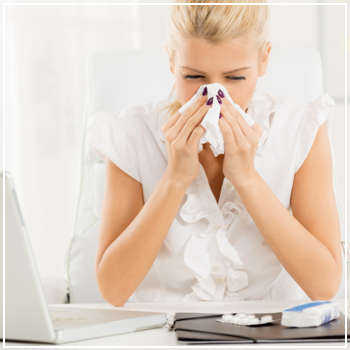Tips to Reduce HVAC System Allergens
 Your HVAC system acts as a channel for air to flow through to various rooms in your home. When allergens find their way into the vents, the heating and cooling system spreads them throughout the home. As a result, you may experience itchy eyes, runny nose or sneezing.
Your HVAC system acts as a channel for air to flow through to various rooms in your home. When allergens find their way into the vents, the heating and cooling system spreads them throughout the home. As a result, you may experience itchy eyes, runny nose or sneezing.
Two key factors let allergens into your HVAC system. One, common home allergens like dust mites, pet dander and pollen pass through the vents and are not caught by the filter. Two, a damp environment inviting moisture may result in mold or mildew inside your HVAC system. These spores taint your home’s indoor air quality and require professional service to remove.
What can you do to prevent allergens?
Invest in Better Filters
Filter quality is correlated to indoor air quality, especially where allergens are concerned. The typical HVAC filters only take in the larger dirt and debris particles, letting everything else pass through.
Filter with a higher MERV rating deliver the degree of filtration you seek. On a scale of 1 to 12, MERV ratings indicate how well a filter blocks particles. Higher numbers indicate better filtration and trapping of smaller particles.
Ideal for people living with allergies HEPA filters are made of layered glass fibers that trap 99 percent of dust, pollen and smoke through a pleated formation.
Supplement Filtration
An air purifier acts as a secondary source to trap small particles and allergens, especially if it’s designed to improve the air quality of the home.
In summer, your strategy needs to address humidity. Especially in hot, damp areas of the country, mold and mildew will thrive. If condensation gathers in certain unseen parts of your home, they’ll likely become a source that go unchecked for the entire season, resulting in unexplained respiratory symptoms. As a solution, add a whole-home dehumidifier to suck extra moisture from the air and reduce the likelihood mold or mildew will start to form in your HVAC system.
Clean Your HVAC System
Specifically target the ducts and filters when cleaning your HVAC system. Although a professional works more comprehensively, homeowners can perform a few basic maintenance tasks between service calls.
For starters, change your filters at least every other month. If the season has a particularly high amount of pollen, you may need to do this more often. By not performing this task, your filters become clogged, causing particles to pass into the ducts and potentially resulting in decreased performance.
Beyond the filters, also clean the heating and cooling ducts to remove any dust, pollen, pet dander and any moisture that may have accumulated.
On the subject of moisture and dirt, aspects like cooling coils, motors, blades and drain pans that haven’t been cleaned may also create a pathway for debris and allergens to build up and pass through your HVAC system, all while causing it to work harder.
Specific home projects necessitate cleaning your filters and ducts. Be sure to add this step after you:
- Have had renovations done, even to a single room
- Got rid of a pest infestation, especially rodents
- Resolved a mold issue in the basement or crawl space
Address Bacterial Buildup
In this instance, mold and mildew might not be the only organisms attracted to the damp, dark conditions of your home’s HVAC system. Mites, fungi and bacteria may also be congregating here and aggravating your allergies.
For these specific cases, filters made of cotton or makeshift cardboard might be attracting pests. To get rid of them, you may need to install UV lights near where their colonies have started to form. This halts their growth, kills existing bacteria and prevents them from spreading further.
If you think your HVAC system is aggravating your allergies, work with MJ Fahy & Sons to have the ducts and filters cleaned. To learn more about our services, contact us today.




